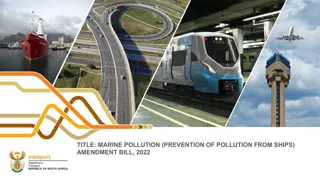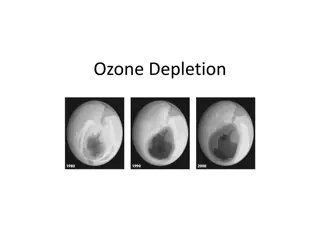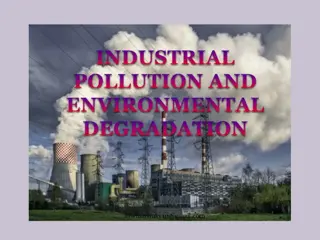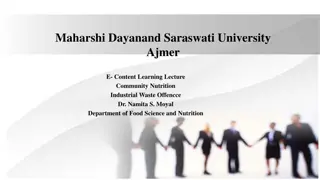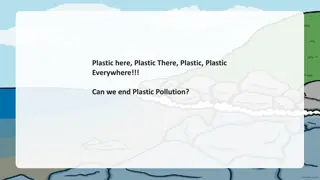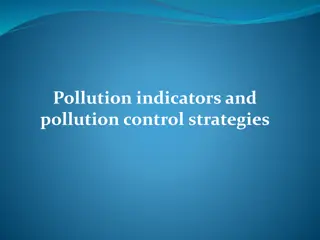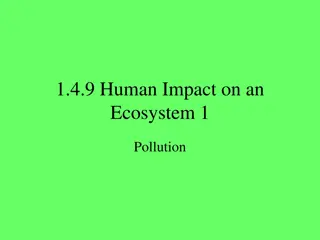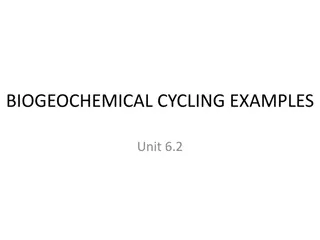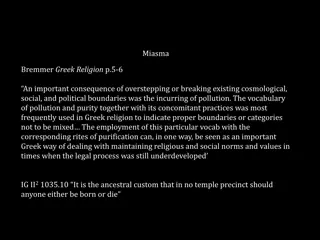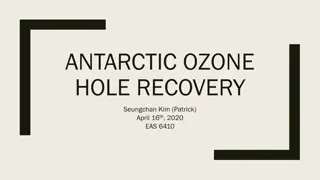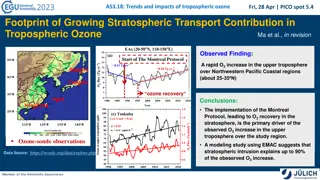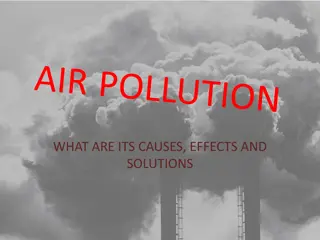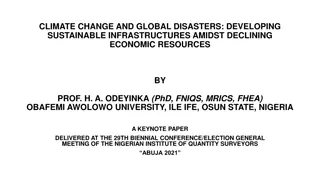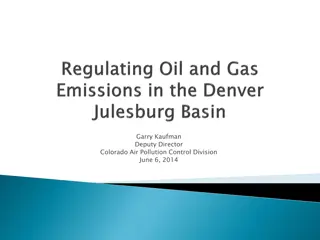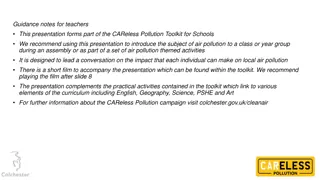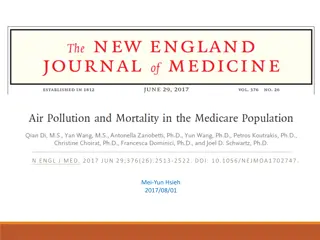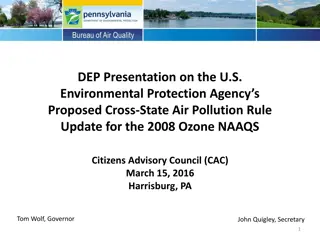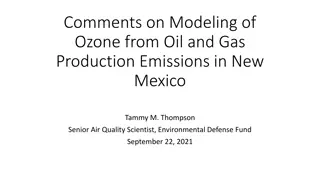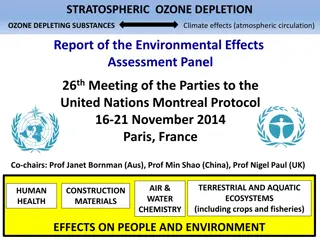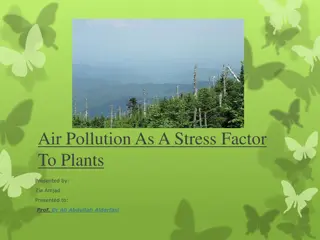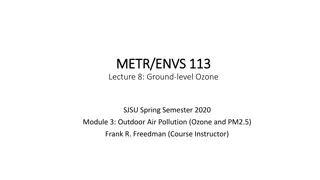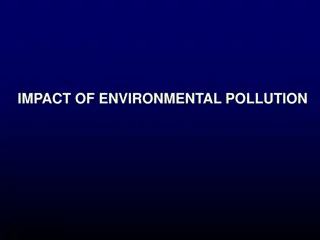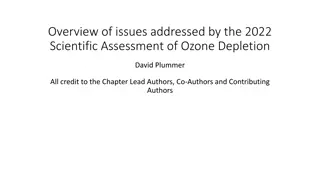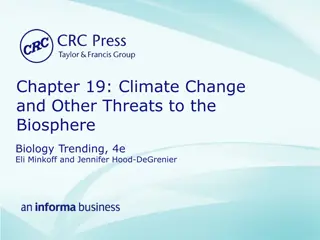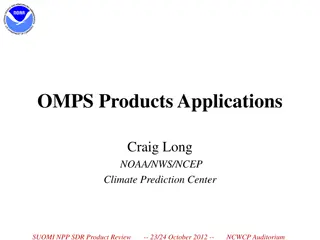Understanding Pollution: Causes, Effects, and Remedies
Pollution, whether natural or manmade, refers to undesirable changes in the environment that impact air, water, and land, affecting human life and natural resources. Various pollutants like carbon monoxide, sulfur dioxide, and nitrogen dioxide contribute to air pollution, which can have harmful effe
2 views • 17 slides
Marine Pollution Prevention Amendment Bill Overview
The Marine Pollution (Prevention of Pollution from Ships) Amendment Bill aims to incorporate MARPOL Annex IV and Annex VI to regulate sewage treatment, reduce marine pollution, and address ship energy efficiency and GHG emissions. The bill seeks to enhance environmental protection by restricting sew
5 views • 15 slides
The Role of Sunlight, Ozone, and Plant Life in Earth's Atmosphere
Sunlight plays a crucial role in the formation of ozone from oxygen, leading to the protection of plant life against harmful UV radiation. The ozone produced by sunlight helps in the photosynthesis process of plants, which in turn release oxygen, absorb CO2, and contribute to the overall balance of
7 views • 23 slides
Best facility for Ozone Therapy in Soho
Hijama Cupping & Ozone Centre serves the Best facility for Ozone Therapy in Soho. They offers a wide range of services including: IV drip, skin whitening, ozone therapy, PRP plasma, hair loss treatment, cupping and much more. Experience the transformative power of ancient wisdom and modern innovatio
0 views • 6 slides
Understanding Ozone Depletion: Causes and Impact
The ozone layer, found in the stratosphere at 15 to 40 km altitude, plays a crucial role in absorbing harmful ultraviolet radiation. However, due to the use of Chlorofluorocarbons (CFCs), the ozone layer has been depleted, leading to the formation of the ozone hole. This depletion is caused by chemi
0 views • 27 slides
Understanding Different Types of Pollution and Ways to Combat Them
Pollution comes in various forms such as water, noise, air, thermal, and land pollution. Each type has specific sources and impacts. Air pollution, caused by industrial activities and burning of fossil fuels, emits harmful substances into the air. Water pollution occurs due to the discharge of chemi
0 views • 13 slides
Advancements in Air Pollution Prediction Models for Urban Centers
Efficient air pollution monitoring and prediction models are essential due to the increasing urbanization trend. This research aims to develop novel attention-based long-short term memory models for accurate air pollution prediction. By leveraging machine learning and deep learning approaches, the s
0 views • 17 slides
Understanding Industrial Pollution and Waste Management
Industrial pollution, stemming from manufacturing activities, poses a significant threat to the environment. This pollution, including air, water, and soil contamination, results in environmental degradation. Industrial waste, both hazardous and non-hazardous, further compounds the issue, requiring
0 views • 15 slides
Understanding Environmental Hygiene: Air Pollution and Composition of Air
The content delves into the concept of atmospheric pollution, the composition of pure and impure air, sources of air pollution, and the zones of the atmosphere. It highlights the detrimental effects of pollutants on health and the environment, emphasizing the importance of environmental hygiene. The
1 views • 27 slides
Taking Action Against Plastic Pollution
Plastic pollution is a pressing global issue that harms both the environment and human health. The excessive use of plastic leads to devastating consequences, such as ocean pollution and wildlife endangerment. This article emphasizes the importance of reducing single-use plastics, adopting recycling
0 views • 8 slides
Understanding Pollution: Indicators and Control Strategies
Pollution is a significant environmental issue, yet often misunderstood. This article delves into the definition of pollution, classification, and considerations for effective pollution control strategies. It discusses the UK Environmental Protection Act of 1990, pollutant properties, toxicity, and
2 views • 50 slides
Understanding Pollution and its Ecological Impact
Pollution is any human addition to the environment that disrupts the ecosystem's ability to sustain life. This includes pollutants like CO2 and chemicals from various sources that harm air, water, and land. Different types of pollution such as industrial, agricultural, and domestic pollution have ad
0 views • 25 slides
Understanding Air Pollution and Its Impact on Health and Environment
Air pollution poses a significant threat to human health, the environment, and the economy. The Clean Air Act has played a crucial role in reducing air pollutants since its establishment in 1963. Criteria air pollutants such as ozone, particle pollution, carbon monoxide, lead, sulfur dioxide, and ni
1 views • 11 slides
Understanding Nutrient Pollution and Its Impact on the Environment
Nutrient pollution, characterized by the excess input of nitrogen and phosphorus into water and air, is a significant environmental issue with far-reaching consequences. It can lead to toxic algae blooms, dead zones, economic losses, and adverse effects on human health. The causes of nutrient pollut
2 views • 11 slides
Understanding Pollution and Purification in Greek Religion
The concept of pollution and purification played a crucial role in maintaining religious and social norms in ancient Greek society. Breaking boundaries or defying societal expectations could lead to pollution, necessitating purification rituals. Examples of actions that could cause pollution include
0 views • 7 slides
Antarctic Ozone Hole Recovery and Future Challenges
Depletion of the stratospheric ozone layer in Antarctica due to chlorine emissions led to the formation of the ozone hole. Since the phasing out of Ozone-Depleting Substances (ODSs) under the Montreal Protocol, there has been a reduction in anthropogenic ODSs in the troposphere. Observations and che
0 views • 12 slides
Comprehensive Environmental Chemistry Open Course Overview
This open course offered by the Department of Chemistry covers various aspects of environmental chemistry, including air and water pollution, soil pollution, noise pollution, thermal pollution, and radioactive pollution. Students will learn about the causes and effects of different types of pollutio
3 views • 9 slides
Analysis of Emergency Engines and Ozone Levels in Demand Response Events
Use of emergency engines in demand response (DR) events does not correlate with high ozone levels, as shown by a study conducted from 2005 to 2011 across various regions like PJM, ISO NE, NYISO, and ERCOT. The analysis reveals that emergency DR events do not align with high ozone days, indicating no
0 views • 12 slides
POLLUTION PREVENTION: A Closer Look at Environmental Initiatives in Oklahoma
Explore the evolution and implementation of pollution prevention measures in Oklahoma, focusing on statutory directives, recent activities, recycling efforts, tax credits, and more. The Pollution Prevention Act of 1990 plays a crucial role in reducing environmental hazards through the reduction of p
0 views • 31 slides
Surface Ozone Seasonal Cycle Reversal Study in Northeastern United States Lower Manhattan
Study on the reversal of the surface ozone seasonal cycle over Northeastern United States Lower Manhattan, analyzing the impact of NOx and VOC emissions on Surface O3 levels. Research shows a 26% decrease in regional NOx emissions leading to changes in the seasonal cycle of surface ozone concentrati
0 views • 24 slides
Understanding Ozone Depletion and Its Impact on the Environment
The stratosphere contains a vital layer of ozone that shields the Earth from harmful UV radiation. However, human activities, particularly the use of chlorofluorocarbons (CFCs), have led to the depletion of this protective ozone layer, especially over the poles. This thinning of ozone poses signific
0 views • 10 slides
Impacts of Tropospheric Ozone and Stratospheric Transport Contribution
The study examines the trends and impacts of tropospheric ozone, focusing on the significant increase observed over the Northwestern Pacific Coastal regions. It explores the primary drivers behind this ozone increase, attributing up to 90% to stratospheric intrusions as a result of the Montreal Prot
0 views • 6 slides
Understanding Air Pollution: Causes, Effects, and Solutions
Pollution is the harmful introduction of contaminants into the environment, caused by human activities and natural disasters. It impacts all living organisms, making it challenging to sustain life. Air pollution, a major form of pollution, occurs when pollutants such as gases, dust particles, and fu
0 views • 8 slides
Developing Sustainable Infrastructures Amid Climate Change and Global Disasters
Prof. H.A. Odeyinka's keynote paper discusses the importance of developing sustainable infrastructures amidst declining economic resources in the face of climate change and global disasters. It highlights the concepts of climate change, sustainable development, atmospheric layers, ozone layer, carbo
0 views • 25 slides
Study on Lower Tropospheric Ozone Increase in Indochina Peninsula
Research conducted in Hanoi, Vietnam, reveals an increase in lower tropospheric ozone over the eastern edge of the Indochina Peninsula. The study focuses on understanding the three-dimensional distribution and temporal variation of ozone to comprehend air pollution and atmospheric variability. Findi
0 views • 11 slides
Strategies for Oil and Gas Emission Reduction in Colorado
Garry Kaufman, Deputy Director of the Colorado Air Pollution Control Division, outlines efforts to reduce air pollution from oil and gas emissions, focusing on past initiatives, ozone standards, and methane reduction strategies. The historical context sheds light on the evolution of regulations and
0 views • 25 slides
Addressing Air Pollution in Schools: A Presentation and Toolkit Overview
Introduction to air pollution using a presentation from the CAReless Pollution Toolkit for Schools. Covers what air pollution is, its causes, and the specific impact on areas like Colchester and schools. Aimed at starting a conversation on individual actions to combat local air pollution, complement
0 views • 16 slides
Drawbacks of City Living: Traffic Jams, Pollution, and Overcrowding
Living in a city presents several challenges including traffic jams due to increasing population, pollution affecting health and the environment, and noise pollution from construction activities. These factors make city life difficult for residents. The content discusses the drawbacks of city living
2 views • 8 slides
Long-Term Air Pollution Exposure and Risk of Death
This study aimed to assess the risk of mortality associated with long-term exposure to low levels of air pollution in areas beyond well-monitored urban regions. Using Medicare beneficiary data and advanced modeling techniques, the research focused on estimating the impact of PM2.5 and ozone concentr
0 views • 17 slides
U.S. EPA's Proposed Cross-State Air Pollution Rule Update for 2008 Ozone NAAQS
The U.S. Environmental Protection Agency (EPA) issued the Cross-State Air Pollution Rule (CSAPR) in 2011, aiming to improve air quality by reducing power plant emissions across state lines. Challenges and subsequent revisions led to the proposed CSAPR Update Rule in 2015, targeting interstate air po
0 views • 27 slides
Modeling the Impact of Oil and Gas Emissions on Ozone in New Mexico
Tammy M. Thompson, a Senior Air Quality Scientist at the Environmental Defense Fund, discusses the modeling of ozone from oil and gas production emissions in New Mexico. The analysis focuses on areas with high ozone concentrations and their overlap with oil and gas regions, highlighting the sensitiv
0 views • 8 slides
Impacts of Stratospheric Ozone Depletion on Ecosystems and Human Health: 2014 Assessment Report
Significant scientific advances in understanding the effects of stratospheric ozone depletion on ecosystems and human health were presented in the 2014 Assessment Report. The report assessed research covering various subject areas and highlighted the increased UV-B radiation levels due to ozone depl
0 views • 20 slides
Understanding Air Pollution Stress on Plants
The impact of air pollution on plants is a significant concern, affecting their physiology and overall health. Various air pollutants, such as sulfur dioxide, ozone, and nitrogen compounds, have been identified as phytotoxic agents, leading to severe or subtle effects on plant life. Detecting the ef
0 views • 21 slides
Understanding Ground-Level Ozone Pollution: Health Effects and Historical Perspective
Ground-level ozone, a secondary pollutant formed by NOx and VOCs, poses significant health risks such as lung inflammation and respiratory illnesses. This article delves into the adverse effects of ozone inhalation, regulatory efforts, and a historical perspective, including the alarming levels reco
0 views • 24 slides
Understanding the Impact of Environmental Pollution
Environmental pollution, caused by the introduction of contaminants into the air, water, and soil, has detrimental effects on ecosystems and human health. This pollution includes air pollution from various sources like combustion and industrial processes, leading to the formation of harmful pollutan
0 views • 61 slides
Understanding the EPA's Ozone Advance Program and Clean Air Act
The content covers key information about the EPA's Ozone Advance Program, including the basics of ozone, the Clean Air Act requirements, designation vs. classification, classification deadlines, and marginal classification requirements. It explains the formation of ozone, the importance of reducing
0 views • 40 slides
Insights from 2022 Scientific Assessment of Ozone Depletion
The 2022 Scientific Assessment of Ozone Depletion, led by David Plummer, addresses key issues like Ozone Depleting Substances, HFCs, Global and Polar Stratospheric Ozone, Climate Impacts, Stratospheric Aerosol Injection, and more. Chapter details reveal decreasing trends in Ozone Depleting Substance
0 views • 12 slides
Impact of Climate Change and Pollution on the Biosphere
The chapter discusses the significant threats posed by climate change and pollution to the biosphere, including the water cycle, atmospheric changes, and the effects of human activities on aquatic and air pollution. It addresses issues like acid rain, ozone depletion, and global warming. The content
0 views • 20 slides
Ozone Observational and Monitoring Activities in Algeria and Burkina Faso
Algeria's National Meteorology Office conducts ozone monitoring at GAW stations in Tamanrasset City and Assekrem. Calibration and data reporting are done regularly to WOUDC. In Burkina Faso, NAMA-BF oversees meteorological observations and is acquiring instruments for ozone monitoring. Collaboration
0 views • 20 slides
Understanding OMPS: Ozone Mapping Profiler Suite and its Applications
OMPS is a vital tool for monitoring global ozone levels, offering precise measurements through its mapper, profiler, and limb profiler components. This advanced suite builds on decades of ozone monitoring heritage, providing valuable insights for researchers and policymakers. By comparing with exist
0 views • 18 slides

